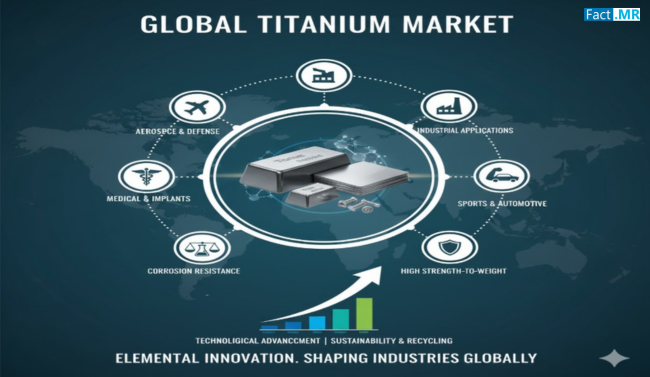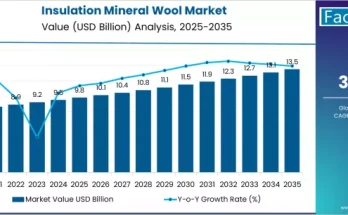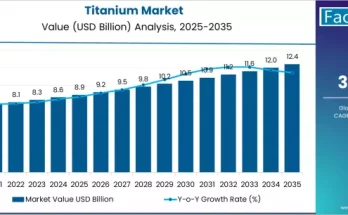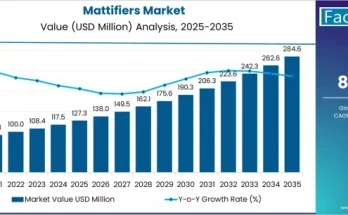The titanium market is experiencing robust growth as industries increasingly seek materials that combine strength, lightweight properties, and corrosion resistance. Titanium, known for its exceptional mechanical and chemical characteristics, is widely used in aerospace, automotive, medical, chemical, and energy sectors. Its versatility, along with the growing emphasis on high-performance materials, positions titanium as a key component in modern industrial and technological applications.
Market Overview:
Titanium is available in multiple forms, including titanium metal, titanium dioxide, titanium concentrate, titanium alloys, and titanium tetrachloride. Titanium dioxide, known for its bright white pigmentation, is extensively used in paints, coatings, plastics, cosmetics, and paper industries. Titanium metal and its alloys offer superior strength-to-weight ratios, making them indispensable in aerospace, automotive, and marine applications. The material is resistant to corrosion, heat, and chemicals, allowing for longer product lifespans and reduced maintenance costs.
Regional Insights:
North America leads the titanium market due to its strong industrial base, advanced aerospace and medical sectors, and high adoption of innovative manufacturing technologies. Europe follows, with demand driven by automotive, construction, and energy industries emphasizing sustainability and durability. Asia-Pacific is emerging as a high-growth region, particularly China, which is investing heavily in aerospace manufacturing, medical equipment production, and industrial applications. Government initiatives to enhance domestic manufacturing capacities further support market expansion in the region.
Key Trends & Forecast:
- Aerospace Expansion:Titanium alloys are critical in aircraft manufacturing due to their light weight, strength, and resistance to extreme temperatures. The rising production of civil and military aircraft globally is driving demand for titanium.
- Automotive Lightweighting:Automotive manufacturers are increasingly using titanium to reduce vehicle weight, improve fuel efficiency, and lower carbon emissions. Components such as exhaust systems and springs benefit from titanium’s durability and performance.
- Medical Applications:Titanium is widely employed in medical implants, prosthetics, surgical instruments, and dental devices. Its biocompatibility, corrosion resistance, and mechanical strength make it ideal for healthcare applications.
- Innovations in Nanomaterials:Ultrafine titanium dioxide nanomaterials are used in cosmetics, sunscreens, and building materials for enhanced UV protection, brightness, and self-cleaning properties.
Applications & End-Use Outlook:
Titanium’s diverse properties make it suitable for multiple industries:
- Aerospace & Defense:Aircraft frames, engine components, and structural elements benefit from titanium’s lightweight and high-strength properties.
- Automotive:Titanium alloys reduce vehicle weight, enhance fuel efficiency, and provide durability for high-performance components.
- Medical & Healthcare:Titanium implants and surgical instruments ensure biocompatibility, reducing the risk of infection and enhancing patient safety.
- Construction & Industrial:Titanium dioxide is used in coatings, paints, and plastics for durability, UV protection, and aesthetic appeal.
- Energy & Marine:Titanium’s resistance to corrosion makes it ideal for power plants, desalination plants, offshore structures, and chemical processing equipment.
Opportunities in Emerging Markets:
Emerging markets, particularly in Asia-Pacific, present significant growth potential. China dominates regional demand due to rapid developments in aerospace, medical devices, and industrial infrastructure. India, Southeast Asia, and other developing economies are witnessing increasing titanium adoption driven by urbanization, rising industrial output, and infrastructure investments. Expansion into these markets offers opportunities for manufacturers to establish production facilities, form strategic partnerships, and develop localized product offerings.
Challenges & Market Restraints:
Despite its advantages, titanium production faces certain challenges:
- High Production Costs:Extracting titanium from ores and processing it into metal or alloys is expensive and energy-intensive, limiting accessibility for cost-sensitive industries.
- Strict Environmental Regulations:Manufacturing processes, especially the sulfate and carbo-chlorination methods, require compliance with environmental standards, adding operational complexity.
- Supply Chain Limitations:Mining, ore processing, and distribution involve multiple stages and high capital investment, which can constrain supply and raise costs.
Country-wise Insights:
China holds a dominant position in the Asia-Pacific titanium market due to its strong aerospace and industrial sectors. The United States maintains a significant market share, driven by established healthcare facilities, high-end aerospace production, and growing adoption in automotive and industrial applications. Europe’s demand is supported by sustainability-driven construction projects, advanced manufacturing, and regulatory standards promoting high-quality materials.
Conclusion:
The titanium market is poised for sustained growth as demand increases across aerospace, automotive, medical, and industrial sectors. Its unique combination of lightweight, strength, corrosion resistance, and biocompatibility makes titanium indispensable in modern manufacturing and innovation. Companies investing in research, process optimization, and emerging markets are well-positioned to benefit from the expanding opportunities presented by this versatile metal.



